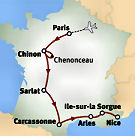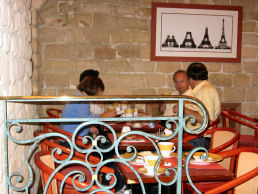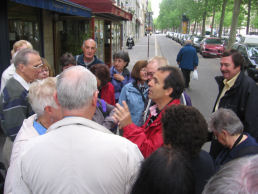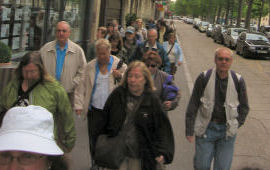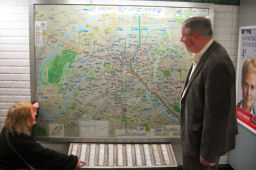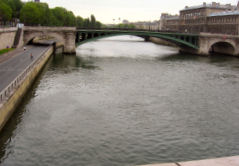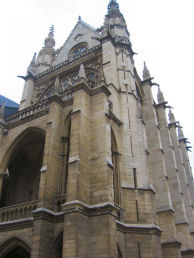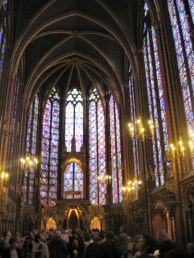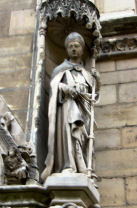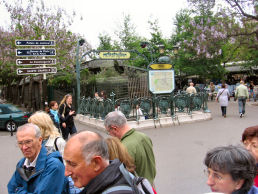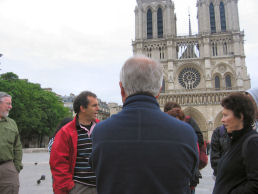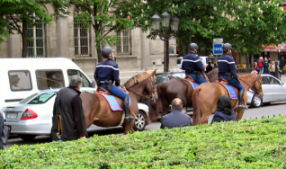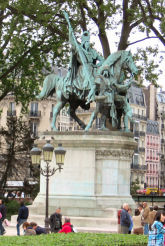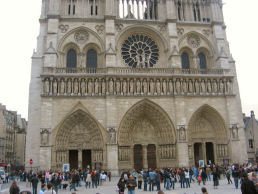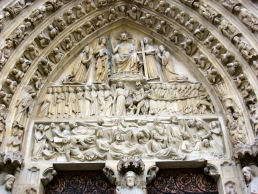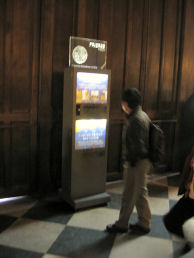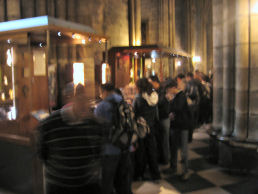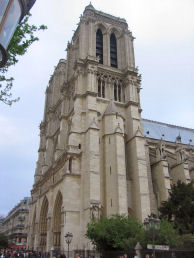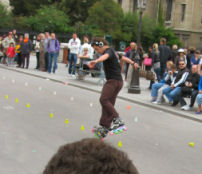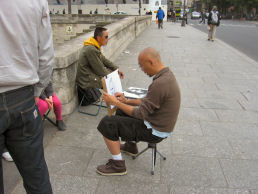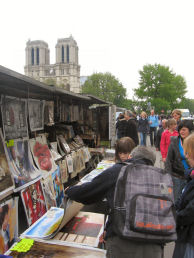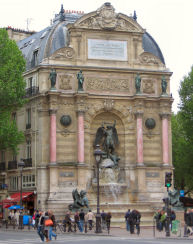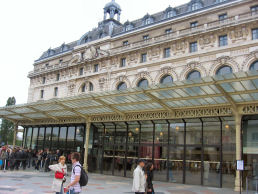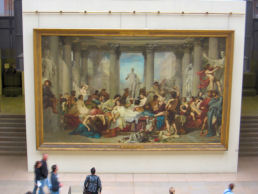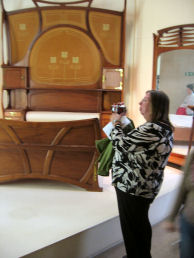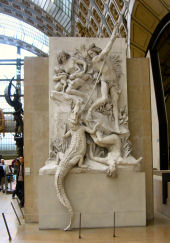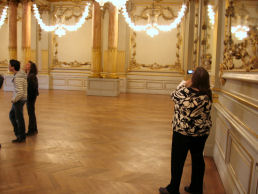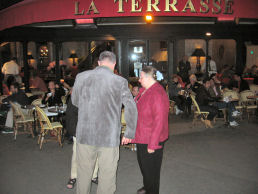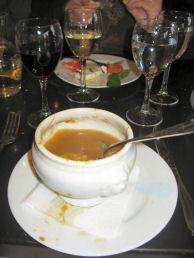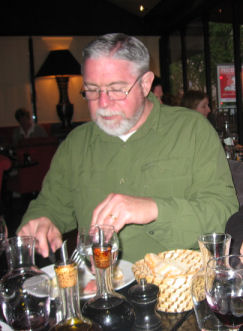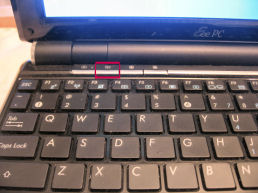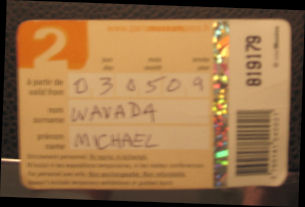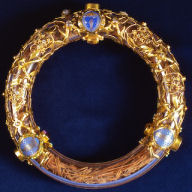I slept quite soundly once I got to sleep. I awoke at a little after six, which is late for me. Both Sue and I felt unusually stiff and sore. It would have been very pleasant to stay in bed for another few hours, but we did not come all this way to lie around in a cramped hotel room.
We went down to the breakfast room at a little after seven. The fare was exactly the same as on Saturday. Sue and I both ordered coffee black, but they brought us a pitcher of milk anyway. Tom and Patti joined us a few minutes later.I could not recall much coughing or sneezing on any previous trip to Europe, but I had done both quite a bit in Paris. Maybe it was the pollution. Maybe some kind of pollen to which I am sensitive was prevalent in Paris in early May. It seemed worse in the hotel room than elsewhere.
The tour group met outside the hotel at 8:30. Roscoe and Gigi Carnahan took off on their own adventure. Even though Patrick had never told us to pair up, we discovered that everyone had buddies except for five of us, including Patti, Tom, and me,. Almost immediately the other two became buddies. Patrick told Tom and me to buddy up with the Carnahans, which would leave Patti with no buddy. Oh, well. Patrick gave each of us a Museum Pass, which was good for two days in most galleries and museums in Paris for two days, and four Métro tickets. We then paraded through the nearly deserted streets of Paris toward the École Militaire station. Evidently Sunday mornings are not very lively in Paris. The Métro station was also nearly empty.Patrick showed us on a lighted map on a wall inside the station how we were to proceed to the Ile de la Cité. At the end of the demonstration someone asked him to show us using the lights how to get to our ultimate destination, which was Chatelet.[1] The board selected the wrong route, and a few of its lights did not work.
Everyone made it to Chatelet, which was on the right bank of the Seine, without any trouble. We then walked across the bridge to the Ile de la Cité. Our destination was Sainte-Chapelle, a very old church that was totally surrounded by the Ministry of Justice. For that reason we had to go through security in order to enter the area. We had to put our bags and jackets through the x-ray machine and walk through a metal detector. They did not hassle anyone, and they even let us keep our shoes on. When we reached Sainte-Chapelle, we proceded directly to the upper chapel, which had been constructed by the saintly king, Louis IX, as a suitable repository for the Crown of Thorns and other religious relics that he had purchased from Constantinople. According to Patrick, the relics cost more than the construction of the chapel. Louis was willing to pay top franc for them because the salesman assured him that the Crown had only been used once. The building was strictly a tourist attraction; it no longer functioned as a church at all.The most impressive aspect of this place was the set of stained glass windows. They tell a number of stories from the Bible, but that was of little relevance since no one could possibly make out any above the lowest ones. The amazing thing was that any light at all came through them. The windows were virtually undetectable from the outside. The light came through barely visible narrow vertical apertures in the wall. Evidently that provided enough to illuminate the windows in a spectacular fashion.
Rick Steves said to take a picture of the ceiling, so I did.A few minutes of reverent gawking was enough for me. Little by little the group gathered outside of the chapel. I asked Patrick about the two statues on the side of the wall. The one with the crown was clearly King Louis IX. The other wore a miter, so he must have been a bishop. Patrick speculated that it might have been the Bishop of Paris at the time. I did not have a better explanation. I also asked Patrick about the house that was over the heads of the statue of one of the saints inside. He said that it was the coat of arms of Louis’s mother Blanche.[2]
I asked Patrick what became of the Crown of Thorns. He told me that it was now kept in Notre Dame.[3]
The guidebook had awarded the chapel with three pyramids. I could not understand why. It had some cool windows and an interesting ceiling, but so did hundreds of churches. Maybe I missed something.We made the short march together over to Notre Dame. As we walked past it, Patrick pointed out the Art Nouveau Métropolitain station. The guidebook said that “on Sundays this square flutters with a busy bird market.” We were there on a Sunday morning, but I never saw any sign of a bird market.
Patrick sat us down on a wall on the side of the square. He explained that all churches in France built before 1789 had been confiscated by the revolutionary government and were still considered state property. The government let the Church use some of them, including Notre Dame. Patrick said that construction of Notre Dame was begun in 1163 by Bishop Sully and completed in 1345. So, it was begun long before Sainte-Chapelle but finished much later. It did not take that long to pile the stones one on another; some later bishops had different priorities for spending their money. While he was explaining all of this to us, the church's bells started to toll. Since the sound was directed down to the square by louvers, it was almost unbearably loud. The bells announced the start of Sunday mass. We tarried outside while Patrick explained some of the iconography of the carvings on the doors. Patrick made the interesting point that the artists seemed to have a lot more fun with the condemned humans than with the saved. I have to say that I was not that impressed with the façade. We had seen quite a few churches in Italy with more awesome façades. Mass had just begun when we entered the church. Several hundred people were in the pews in the center of the nave attending mass. Surrounding them was a like number of tourists walking around and jostling one another for the best view of the priest and the two men in blue robes who were leading the singing. This really creeped me out. I am not even slightly religious, but I just could not abide being among tourists who were treating the celebration of the mass as a performance put on by the natives. I felt so uncomfortable that I paid almost no attention to the interior and departed just as soon as I could. I was also grossed out by the fact that whoever manages the building was running a bookstore inside the church, and it was doing the proverbial land office business during the mass. Near the bookstore were machines that dispensed holy cards and other such souvenirs. Small candles cost 2€; the big ones went for five. Tom Stan mentioned that Loraine lit one. For me, Notre Dame was the biggest disappointment of the entire tour. Based on what I had read, I thought that there was much more to it than we (or at least I) experienced. I would have liked to catch at least a glimpse of the flying buttresses and to climb the tower. I would have liked to spend more time exploring the interior when it did not seem quite so creepy to do so.[4] I would also have liked to meet Quasimodo or Esmeralda. Our visit to Notre Dame was followed by a walk across the bridge to the Left Bank. As we crossed back onto the mainland, we were entertained by a guy wearing headphones and roller blades slaloming around little markers.We then walked along the bank where dozens of vendors were selling books, postcards, and art work. Our morning ended at the St. Michel square, which is named after the archangel overlooking a rather large fountain. It was almost lunch time, so we dispersed into the nearby Latin Quarter.
Tom Corcoran was hungry for a sandwich, so he and Patti set off in search of a place to purchase one. Sue and I just wanted to sit down, and I desperately wanted to get out of the chill. Motivated by the fact that it was right next to where we were standing, we went into the Café Le Saint Séverin and ordered cappuccinos. They were passable if outrageously expensive. Later Patti joined us and had one, as well. Tom sauntered off to descend toward the river and eat his sandwich. He reported to us later that riverside was really nice.
Sue got up to use the restaurant’s toilet. When she returned to the table, she disclosed that the café had a coin-operated toilet, but they provided their customers with slugs. Probably a lot of passersby hear nature’s call after communing with the nearby fountain for a few minutes.
After lunch the group reassembled by the fountain and then took the Métro to the Orsay Museum, which is housed in a converted railway station. This arrangement must have posed a significant challenge to the architect. It had five floors of exhibits, but the expansive center area went all the way up to the roof. So, all of the exhibits on the floors above the ground floor were restricted to the sides as were all of the stairs, elevators, and escalators. Patrick explained that this museum specialized in the period from 1848, when short-lived revolutions spread through Europe, to the onset of World War I in 1914. The art from before 1848 is in the Louvre. The more modern works are in the Pompidou. Most people, however, think of the Orsay as an impressionist museum. Patrick told us that the statues of sitting women on one side of the square in front of the museum represented the seven continents. If Antarctica got a statue, I would have expected it to be a penguin. How did they determine which continents were bare-breasted? Because admission to the museum was free on the first Sunday of the month, a huge crowd was queued up to get in. Flaunting our museum passes, we were allowed to enter through a side door that had a much shorter line. We did have to pass through security, but it was only nominal.Tom went off on his own. Sue had some kind of a plan of what she wanted to see. Since Patti and I did not really care about this museum at all, we just followed her. The three of us skipped the first floor entirely and took the escalator that was on the far end of the museum up to the second floor. We examined a few pieces of art work there, but most of our time was spent photographing furniture. Maybe Jana Mae and Va Bene Bunny were trying to outfit their new place.
Eventually we made our way to what Sue really wanted to see, the railroad station’s dance hall. The floor and the chandeliers have been preserved. The chandeliers put out so much light that it was difficult to take photographs. Sue's leg was beginning to bother her, so she took the elevator down. Patti and I climbed down the stairs. The three of us exited the building and somehow found our way to the RER station. We then used our Métro tickets to get to Invalides. From there we took the trusty #8 to École Militaire.When we got back to the hotel, I asked the lady at the desk for the name of the SMTP server used by the hotel’s network. She did not know what I meant by an SMTP server, but she was able to tell me that the hotel used the Orange network, which was one of the largest in France. I thanked her.
I decided to take a shot at a default name for an SMTP server. I recorded the name of my Wavada.org server in my notebook. Then I changed the setting to be smtp.orange.fr for mike@wavada.org. I tried sending an e-mail from that account. To my great surprise, it did not get bounced back. I changed the other e-mails to use that account and sent them. They all seemed to go through.
I then wasted no time in hitting the sack for a nap. Patti and Tom dropped by at about seven to collect us for supper. Our plan was to find a nice restaurant, eat, and then take a cab to Pont D'Alma where we would catch a boat cruise on the Seine. Patrick had told us that dining in Paris was great, and the boat cruise on the Seine was great, but combining the two diminished both experiences. We had therefore scotched the idea of the dinner cruise. The restaurant that we decided to try was La 7eme Vin, which was a short walk from the hotel. Unfortunately, there was a twenty minute wait. Based on our experience of the previous night, we decided not to chance it. We went to the nearby La Terrasse du 7eme, which had no line at all. Sue and I shared a comfy two-person chair that was unlike anything that I had seen in a restaurant. Patti and Tom had individual seats. I ordered the onion soup as an entrée. It was very good, and it brought home to me how pitiful the onion soup in Corcoran’s Pub had been. I shocked Sue by ordering the lamb curry, which was just spicy enough for my palate. The cappuccino that I ordered later was sub-par. Patti had her usual tomato, basil, and mozzarella entrée. Her main course was salad with chicken (and ham that she did not want). I think that she had dessert, too, and some coffee. Sue ate the rabbit tureen, lamb curry, and caramelized pudding. Tom went for the onion soup, beef roast, and coffee. We also had some wine, but I did not write down what kind it was.Best of all, it was nice and warm in the restaurant. The meal cost an arm and a leg, but, after all, this was Paris. The service was good, and most of the food was quite tasty. We would just have to try to get by without a few of our limbs on the rest of the tour.
Halfway through the meal I decided not to go on the cruise after all. It was already after nine o'clock, I was dog tired, and I really wanted to spend some time on this journal. I did not want to get too far behind so early in the trip; it has always been difficult to catch up. Sue, who was always up for some excitement in the evening, surprised me by deciding that she did not want to go either. The additional walking probably put her off. Moreover, this would give her a chance to put ice on her knee.Patti and Tom took a cab to the docks. Sue and I walked the few blocks back to the hotel. On the way I saw a guy on a moped delivering Domino’s Pizza.
After supper I tried to use the computer, but something had happened to the display when I used the “Sue and Mike” user ID. The icons on the desktop were larger than they had previously been. The worst part was that in every application the window no longer fit on the screen. No matter what program you were running, you had to page right and page left over and over.
The “Sue” user ID was OK, but it did not have any of my e-mail settings, and none of my programs were readily available. If we could not get the configuration back to the way it was, I would either have to use a very kludgy setup for several weeks, or I would have to spend several hours of vacation time constructing a new environment like the “Sue and Mike” one. Neither of these alternatives appealed to me at all.
I blamed Sue for this mess, and that was a serious mistake. We both spent a good bit of time trying to fix it. Sue tried to undo everything that she had done to the environment, but it was to no avail. I tried adjusting several settings in the Control Panel with the same lack of success. After a few bitter words, I went to bed angry at her, and I am sure that she was fed up with me, too.I could not sleep at all, even with earplugs. I got out of bed at 1:30 with several things on my mind. I could not remember where I had placed my museum pass, and I wanted to make sure that it was safe. I also wanted to test whether I could send an e-mail to myself. I started up the little PC in the bathroom, and I had a sudden inspiration to try pressing the second button from the left above the top row of the keyboard. Voile! The screen was back to normal.
I could hardly believe my luck. I tried to send myself an e-mail, and it went through. I was on a roll. Here is an old favorite: How many computer programmers does it take to change a light bulb? For the answer click here.I secured my museum pass in my money belt. I would need it for the Louvre in the morning.
Sue had sent me an e-mail that stated that my name had been removed from her contact list. She asked me to respond to her e-mail. I tried several different ways to let her know that I had not touched her contact list, but all the e-mails were bounced back with a message that they could not find aol.com. This seemed like a pretty strange message to receive; I had no difficulty reaching aol.com using the browser.
I also discovered that I had received an e-mail from Jana Liberská, Sue’s relative in Kutná Hora in the Czech Republic. She was writing to inform us that because of the economic slump she would not be coming to the U.S. this summer. I was too tired to compose anything on the spot, but I meant to make sure that I responded as soon as I could. I was sure that it would surprise her to learn that we were in Paris when we received the message.
I went into the bathroom and wrote a few sentences in the journal. Then I went to bed, pretty well assured of getting some sleep this time.
[1] The word has only two syllables in French, SHAHT-LAY.
[2] There may have been a misunderstanding. I saw these houses (or castles or something) over the heads of many religious images in France.
[3] I later learned that the Crown of Thorns (which no longer has any thorns at all) was put on display in Notre Dame on the first Friday of every month. We actually could have seen it if we had been willing to forgo the trip to Versailles. I also read that at one time seven hundred different thorns were claimed (by various people) to have been part of the Crown.
[4] I complained about the scheduling of the visit to Notre Dame in my evaluation of the tour. Everything else that I wrote was posted on ricksteves.com, but I was surprised to discover that someone had censored those remarks.
